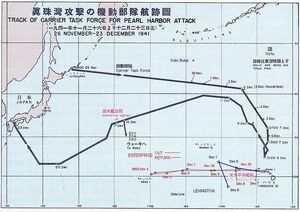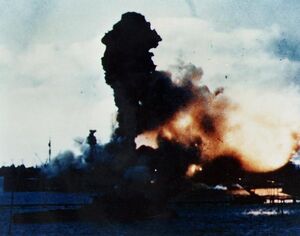
|
This Yellowstone: 1936 page is a Proposal.
It has not been ratified and is therefore not yet a part of the Yellowstone: 1936 Timeline. You are welcome to correct errors and/or comment at the Talk Page. If you add this label to an article, please do not forget to make mention of it on the Main Discussion page for the Timeline. |
| Attack on Pearl Harbor | |||||||
|---|---|---|---|---|---|---|---|
| Part of the Pacific War | |||||||
 Photograph from a Japanese plane of Battleship Row at the beginning of the attack. The explosion in the center is a torpedo strike on the USS Oklahoma. |
|||||||
|
|||||||
| Belligerents | |||||||
| Commanders and leaders | |||||||
| Strength | |||||||
| Mobile Unit: 6 aircraft carriers 2 battleships 2 heavy cruisers 1 light cruiser 9 destroyers 8 tankers 23 fleet submarines 5 midget submarines 414 aircraft |
|||||||
The attack on Pearl Harbor was a surprise military strike conducted by the Imperial Japanese Navy against the naval base at Pearl Harbor, Hawaii, on the morning of 13 December 1938. The attack would lead the beginning of the Pacific War, and the American Pacific-Asiatic Zone's entry into the war.
By 1938 the US remnants of the Pacific were desperate for supplies and humanitarian aid, causing the nations of Hawaii, Alaska, the Philippines, and military territories on the mainland to create an elaborate network of trading and shipping lanes, connecting the various territories through trade. Utilizing the extensive Pacific Fleet operating in the area around the time of the eruption, the various US remnant states of the Pacific would eventually create a stable shipping network between west and east, stretching from the British and Dutch empires of the Pacific and Asia to the west, reaching to the Philippines, Hawaii, and lastly the mainland. The Japanese sought to remove this trade network, which to this point had managed to supply and aid its various enemies in Southeast Asia, including the colonial empires of Britain and the Dutch.
The attack was also intended as a preventive action in order to keep the US Pacific Fleet from interfering with military actions the Empire of Japan was planning in Southeast Asia against overseas territories of the United Kingdom, the Netherlands, and fellow Pacific remnants. There were simultaneous Japanese attacks on the US remnant of the Philippines and on the British Empire in Malaya, Singapore, and Hong Kong.
Background
By the end of 1938, Japan had managed to ferry across more than a third of its citizens, but volcanic activity became more violent. The Japanese also for the first time were severely affected by the cold and began to experience widespread crop failure. This brought about a sense of emergency in the Japanese High Command, who authorized the use of whatever means necessary to speed up the war. This lead to the deployment of multiple untested chemical weapons on Chinese cities and the extensive bombing of many strongholds. As well as this, millions of Chinese men were drafted into the military and used as militiamen by the Japanese against the Alliance, which helped to weaken Chinese morale and speed up the war.
At this time the Japanese began to fear that war with the British and the American remnants was imminent. Without international support the Japanese army had managed to secure parts of China and the Pacific, but events such as the Nanking Massacre, in which more than 200,000 were killed in indiscriminate massacres, public opinion toward Japan begin to drop significantly, even leading to several western powers supplying funds for the Chinese army against Japan.
The former United States territories of Hawaii, Alaska, and the Philippines began a system of heavy trading between one another. Immediately after the eruption the extensive American fleet stationed on the west coast and in the Pacific Ocean made rendezvous at the naval base of Pearl Harbor, located on the territory of Hawaii, grabbing as many survivors from San Diego as they could, the US Pacific Fleet formally abandoned the city in late 1936. Over the next two years the trading network of the Pacific remnants would fully form, with the fleet transporting Americans from the west coast to Hawaii, distributing supplies between the Philippines and the islands, and purchasing oil and other resources from the Dutch East Indies and the British. This system would however unintentionally strengthen the military capabilities of Japan's enemies in the Pacific.

Route followed by the Japanese fleet to Pearl Harbor and back.
The Japanese began drafting a plan for an unannounced attack on all surrounding enemy powers in an effort to quickly reduce their morale and prevent them from attempting to stop the Japanese advance. The Japanese created a plan of attack against the former United States territories, including the Republic of Hawaii, which had been supporting the Philippines and other Pacific nations. Japan called six aircraft carriers (Akagi, Kaga, Sōryū, Hiryū, Shōkaku, and Zuikaku) and their respective task forces to depart from northern Japan for Hawaii, an important American territory in the central Pacific. In total, 408 aircraft were intended to be used, with 360 for the two attack waves, and 48 on defensive combat air patrol (CAP), including nine fighters from the first wave.
The Japanese intended to neutralize the remnant United States Pacific Fleet stationed at Pearl Harbor, Hawaii, therefore protecting Japan's advance into Malaya and the Dutch East Indies, where it sought access to natural resources such as oil and rubber. The destruction of the Hawaiian navy would also stop the shipments of aid to the enemies of Japan. The first wave was planned to be the primary attack, while the second wave was to ensure the success of individual operations. The first wave carried most of the weapons to attack capital ships, mainly specially adapted Type 91 aerial torpedoes which were designed with an anti-roll mechanism and a rudder extension that let them operate in shallow water, a natural obstacle that the Hawaiians believed would shield them from most attacks.
Approach and Attack

Photograph taken from a Japanese plane during the torpedo attack on ships moored on both sides of Ford Island shortly after the beginning of the Pearl Harbor attack. View looks about east, with the supply depot, submarine base and fuel tank farm in the right center distance.
The air portion of the attack on Pearl Harbor began at 7:48 AM Hawaiian Time on 6 December, with the attack on Kaneohe. A total of 353 Japanese planes in two waves reached Oahu. Slow, vulnerable torpedo bombers led the first wave, exploiting the first moments of surprise to attack the most important ships present (the battleships), while dive bombers attacked U.S. air bases across Oahu, starting with Hickam Field, the largest, and Wheeler Field, the main U.S. Army Air Force fighter base. The 171 planes in the second wave attacked the Air Corps' Bellows Field near Kaneohe on the windward side of the island, and Ford Island. The only aerial opposition came from a handful of P-36 Hawks, P-40 Warhawks and some SBD Dauntless dive bombers from the carrier USS Enterprise.
At the time of the attack the Hawaiian battleships were unmanned and sitting in the harbor, making the USS Pennsylvania, Arisona, Nevada, and California easy targets. Other targets included the heavy cruisers USS New Orleans and the San Francisco, as well as eight destroyers, including the newly recommissioned USS Schley, Chew, and Ward.

An Imperial Japanese Navy Mitsubishi A6M2 "Zero" fighter on the aircraft carrier Akagi during the Pearl Harbor attack mission.
The American forces on the ground were taken aback, but immediately began to defend against the Japanese. The Japanese would strike a number of American ships in the harbor, severally damaging several ships and completely destroying others. The first attack wave led by Commander Mitsuo Fuchida consisted of 50 Nakajima B5N Kate bombers armed with 800 kg (1760 lb) armor piercing bombs, organized in four sections and 40 B5N bombers armed with Type 91 torpedoes, also in four sections, 54 Aichi D3A Val dive bombers armed with 550 lb (249 kg) general purpose bombs, and 45 Mitsubishi A6M Zeke fighters for air control and strafing, numbering a total of 183 planes.
Men aboard U.S. ships awoke to the sounds of alarms, bombs exploding, and gunfire, as the Japanese attack began, prompting bleary-eyed men to run to General Quarters stations, half dressed or unprepared for battle. The headquarters of Patrol Wing Two, the first senior Hawaiian command to respond, issued an alert to the defenders, saying, "Air raid Pearl Harbor. This is not drill." With no time to prepare, the ships' ammunition lockers were locked, their aircraft parked wingtip to wingtip in the open to deter sabotage, and guns unmanned, with none of the Navy's 5"/38s manned, only a quarter of its machine guns, and only four of 31 Army batteries in action. Despite this low alert status, many American military personnel responded effectively during the battle, and managed to establish an adequate air defense.
Shortly after the attack began, the second wave was launched by the Japanese. Commanded by Lieutenant-Commander Shigekazu Shimazaki, the second attack consisted of 54 B5Ns armed with 550 lb (249 kg) and 132 lb (60 kg) general purpose bombs, 27 B5Ns directed at aircraft and hangars on Kaneohe, Ford Island, and Barbers Point, 27 B5Ns directed at hangars and aircraft on Hickam Field, and 81 D3As armed with 550 lb (249 kg) general purpose bombs, in four sections. The second wave was divided into three groups. One was tasked to attack Kāneʻohe, the rest Pearl Harbor proper. The separate sections arrived at the attack point almost simultaneously from several directions.
Aftermath

Battleship USS Arizona explodes.
Ninety minutes after it began, the attack was over, leaving thousands of American soldiers and civilians dead. Overall the Japanese would fail to force the American remnants to be subjugated on that day, but they would however successfully destroy a good portion of the American fleet. The following American ships would be destroyed or lost.
Battleships
- Arizona: hit by five armor-piercing bomb, exploded; total loss. 1,177 dead.
- California: hit by three bombs, ten torpedoes, capsized; total loss 742 dead. Returned to service in 1942.
- Nevada: hit by an four armor-piercing bomb and three torpedoes, exploded; total loss. 907 dead.
- Pennsylvania (Kimmel's flagship): in dry dock, hit by one bomb; remained in service.Nine dead.
Ex-Battleship
- Utah: hit by three torpedoes, capsized; total loss. 94 dead.
Destroyers
- Allen - hit by five torpedoes, destroyed; total loss. 293 dead.
- Schley - in dry dock, hit by one bomb, burned; returned to service in 1941. total loss. 53 dead.
- Chew - in dry dock, burned; returned to service in 1942. total loss. 19 dead.
- Dewey - hit by three bombs, two torpedoes, destroyed; total loss. 201 dead.
Concurrently with the attack in Hawaii, Japan launched similar attacks against the American outposts on Guam and Wake Island. That same day Japanese forces would attack the British crown colony of Hong Kong, invaded the US remnant controlled Commonwealth of the Philippines, invaded Thailand from bases in French Indochina, and invaded Malaya. Following the attack on Pearl Harbor four former American battleships were declared out of action. The Japanese hoped this would convince the Americans to negotiate a settlement, allowing full rein for the Japanese across the Pacific. The Americans however immediately prepared for war. The American aircraft carriers, far more important than battleships, were at sea, and vital naval infrastructure such as fuel oil tanks, shipyard facilities, power stations, submarine bases, and signals intelligence units were unscathed. Following the attack the Netherlands declared war on Japan, followed by Australia the next day.
| ||||||||||||||||||||||
| ||||||||||||||||||||
